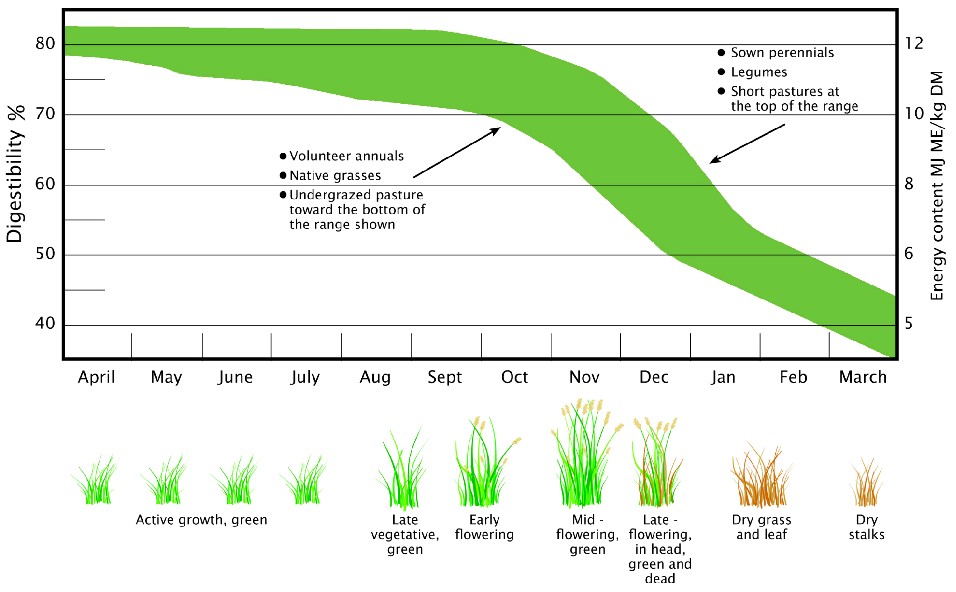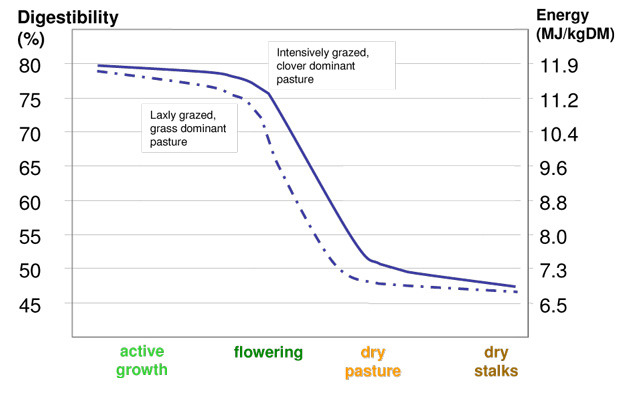|
The productivity of sheep is
largely governed by the
amount of pasture that can
be eaten and it's
nutritional value.
Both pasture quality and
quantity will influence
these factors and need to be
estimated when assessing
pastures to plan for animal
performance. In this section
find information on;
Pasture
Quantity
Pasture
Quality
Digestibility
Digestibility's
relationship with animal
intake and changes with
pasture
composition
Pasture
Quantity - How is it
measured?
The quantity of pasture in a
paddock is estimated in
kilograms of dry matter per
hectare, expressed as kg
DM/ha.
Feed On Offer (FOO) or
Herbage Mass(HM) is a method
to assess amount of pasture
available to the animal and
is assessed by estimating
the dry weight of all above
ground plant material. Some
reference materials may use
a method which relies on
leaving several centimetres
of plant material behind, so
it is worth checking which
method is being used.
The lifetimewool guidelines
use the method that includes
all above ground plant
material unless otherwise
stated. NSW DPI and
Grazfeed® use herbage
mass (further
information).
Measuring pasture quantity
on-farm
To make pasture quantity
assessment more efficient on
commercial grazing
properties, the lifetimewool
project is developing a
‘Photo Gallery' that can be
used in the paddock to
quickly estimate the amount
of green pasture by
comparing what is seen in
the paddock with a range of
photos of known
quantity.
Another commonly used method
involves using a
"pasture stick" or
ruler, to estimate an
average height of pasture
across the paddock, and then
factoring in pasture density
to make an estimate of
pasture quantity. This
method is most accurate when
used on grassy perennial
pastures of even
composition. They are
not suitable for clover
based annual pastures or
pastures that have variable
compositions.
Pasture
Quality - How do we
determine it?
The quality of a pasture for
sheep production is largely
influenced by two main
characteristics. They
are:
1. The digestibility of
pasture present.
2. The proportion
of clover in the pasture
sward.
Figure 1. Digestibility
relationship with dry matter

Digestibility -
What is it, and how is it
measured?
Digestibility refers to the
proportion of plant matter
that is retained in the
animal's body after
eating. For example, a
high quality pasture in its
‘green' state might have a
digestibility of 80%.
This would mean that 80% of
the pasture eaten by the
animal is utilised for body
maintenance and growth, with
the remaining 20% of pasture
passed out as faeces (See
figure 1). All
digestibility measurements
are expressed in terms of
dry matter.
Digestibility and
Metabolisable Energy (ME)
measurements of feed are
directly related. Either
measurement can be used to
describe pasture quality.
Digestibility and ME can be
calculated by a feed testing
house. The relationship
between digestibility and ME
are shown in Graph 1 below.

Graph 1.
Relationship between ME and
digestibility in forages.
Source: FEEDTEST 2006.
Impact
of digestibility on animal
intake
Digestibility of pasture not
only determines the amount
of nutrients that the animal
can extract, but also
influences the speed at
which the plant material is
passed through the
gut. Feed sources
higher in digestibility are
able to pass through the
digestive system faster and
allow the animal to increase
its daily intake. This
is an important concept to
understand as it explains
why high by digestible feeds
have a much greater
potential for animal
production in areas such as
growth, wool production and
lactation.

Graph 2. Energy intake for a
50 kg dry ewe grazing a 1000
kg FOO pasture. This
prediction was formulated
using Grazfeed®.
Digestibility of Green Feed
versus Dead Feed
Green pasture will always be
higher quality (60-85%
digestibility) than dead
herbage (35-60%) of the same
species. The
exceptions are Persian and
Arrowleaf clovers (both
annual species) which are
typically 5-10 units higher
than sub clover in January.
Stage of growth also has a
large influence on pasture
digestibility. Pasture
is of highest quality early
in the vegetative stage and
digestibility gradually
declines as the pasture
progresses through the
vegetative and reproductive
phases, as shown in Figure
2.
Digestibility differences
between species
During the growing season,
there are relatively small
differences between the
digestibility of annual and
perennial grasses, as shown
in Figure 2. However,
towards the end of the
growing season, the quality
of annual grasses declines
quickly as they produce seed
heads and die. In
contrast, perennial grass
species maintain higher
quality for longer, with
varying amounts of green
plant matter present.
Once dead the quality of the
sward can be as low as 35%.
Figure 2. The
digestibility of pasture
species in a typical
season at Hamilton
Source:
Greener Pastures for
South West Victoria,
2006.

Annual pastures, particularly
in a Mediterranean
climate, decline rapidly
after senesence and then
stabilize at around 50%
digestibility (Figure
3). The hotter the
day temperature the
quicker the decline,
with many pastures only
taking 30 days to reach
50%. In cooler
climes, decline may take
up to 60 days to reach
~50%.
Further work on the
conditions affecting decline
is underway.
Figure 3: Digestibility
decline of annual
grasses and clovers in a
Mediterranean
climate
source:
M. Hyder, DAFWA

Clover Content
Sheep will gain weight
faster, grow more wool and
produce more milk when
grazing legume pastures
compared with grass pastures
of the same pasture
quantity. Although
some legume species such as
lucerne, White Clover and
Persian Clover tend to have
slightly higher
digestibility than even the
best perennial grasses, the
main reason for the
increased performance is due
to an increase in animal
intake. Sheep prefer
eating legumes to grass
species and as a result will
tend to eat higher
quantities of feed in
pastures with greater legume
content.

Figure 3. The relationship
between increased clover
content in a pasture and
weight gain in 3 month old
Merino and 2nd X prime lamb
wether weaners, grazing 1000
kg FOO at 75% digestibility.
This prediction was
formulated using
Grazfeed®.
Tools:
Pasture
Photo Gallery
Herbage
Mass compared to FOO
|